1993 CHEVROLET CAVALIER run flat
[x] Cancel search: run flatPage 8 of 308
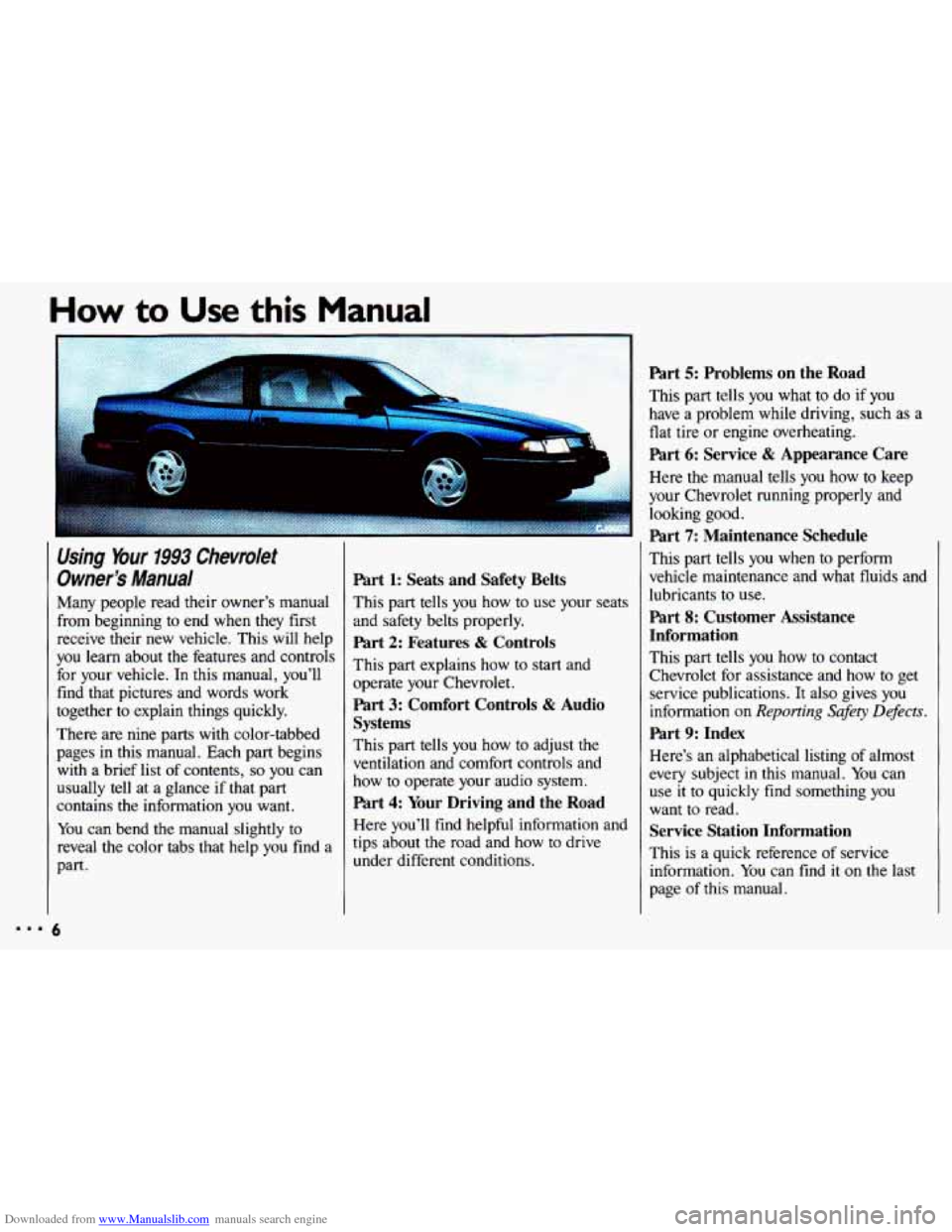
Downloaded from www.Manualslib.com manuals search engine How to Use this Manual
Using Your 1993 Chevrolet
Owner's
Manual
Many people read their owner's manual
from beginning to end when they first
receive their new vehicle. This will help
you learn about the features and controls
for your vehicle.
In this manual, you'll
find that pictures and words work
together to explain things quickly.
There are nine parts with color-tabbed
pages in this manual. Each part begins with a brief list of contents,
so you can
usually tell at a glance if that part
contains the information you want.
You can bend the manual slightly to
reveal the color tabs that help you find a
part.
5
Part 1: Seats and Safety Belts
This part tells you how to use your seats
and safety belts properly.
Part 2: Features & Controls
This part explains how to start and
operate your Chevrolet.
Part 3: Comfort Controls & Audio
Systems
This part tells you how to adjust the
ventilation and comfort controls and
how to operate your audio system.
Part 4: Your Driving and the Road
Here you'll find helpful information and
tips about the road and how to drive
under different conditions.
Part 5: Problems on the Road
This part tells you what to do if you
have a problem while driving, such as a
flat tire or engine overheating.
Part 6: Service & Appearance Care
Here the manual tells you how to keep
your Chevrolet running properly and looking good.
Part 7: Maintenance Schedule
This part tells you when to perform
vehicle maintenance and what fluids and
lubricants to use.
Part 8: Customer Assistance
Information
This part tells you how to contact
Chevrolet for assistance and how to get
service publications. It also gives you
information on
Reporting Safety Defects.
Part 9: Index
Here's an alphabetical listing of almost
every subject
in this manual. You can
use it
to quickly find something you
want to read.
Service Station Information
This is a quick reference of service
information.
You can find it on the last
page of this manual.
Page 56 of 308

Downloaded from www.Manualslib.com manuals search engine Features & Controls
. . ,. .
. ... .
Convenience Net (OPTION)
Your vehicle may have a convenience
net. You’ll see it just inside
the back
wall of the trunk. Put small loads, like
grocery bags, behind the net. It can help
keep them from falling over during
sharp turns or quick
starts and stops.
Unclip a corner of the convenience net
to
fit larger objects behind the net, then
reclip it to secure them in place.
The
net isn’t for larger, heavier loads.
Store them in the trunk as far forward
as
you can.
You can unhook the net
so that it will lie
flat when you’re not using it.
Trunk Cargo Anchors (omoN)
If your vehicle has fold-down rear seats,
you’ll find two or four anchors on the
back wall of your trunk. You can use
these anchors to tie down lighter loads.
They prevent things from shifting during sudden stops, turns and maneuvers.
These anchors are not for heavier loads.
Store those items as far forward in
the
trunk as possible.
New Vehicle “Break-ln”
Your modern Chevrolet doesn’t
need an elaborate “break-in.” But
it will perform better in the long run
if you follow these guidelines:
Don’t drive at any one speed-
fast or slow-for the first
500
miles (804 km 3on’t make full
throttle starts.
first 200 miles (322 km) or so.
During this time your new brake
linings aren’t yet broken in.
Harc
stops with new linings can mean
premature wear and earlier replacement. Follow this
“breaking-in” guideline eveq
time
you get new brake linings.
Avoid making hard stops for 1
Page 156 of 308
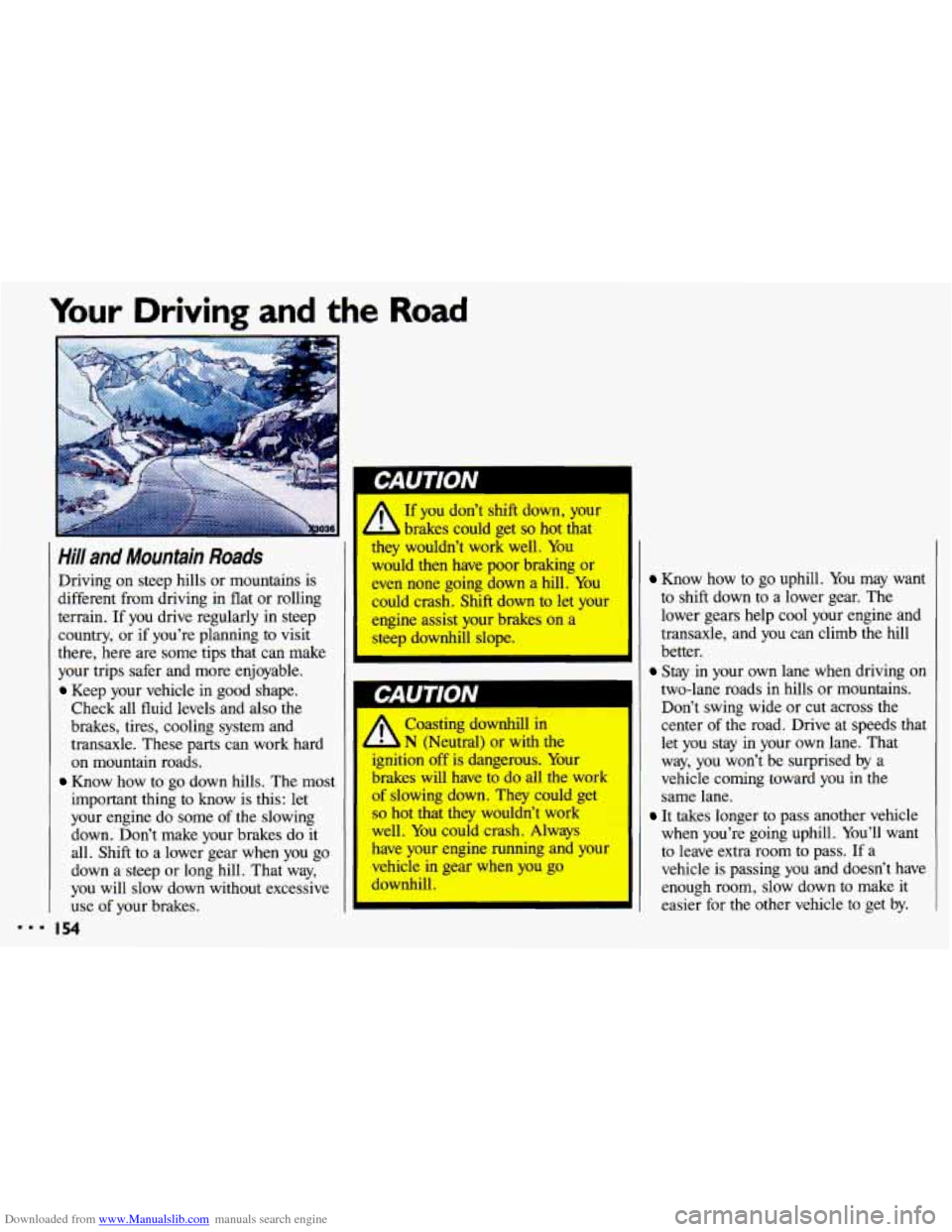
Downloaded from www.Manualslib.com manuals search engine Your Driving and the Road
mmm ‘I
”- .
Hill and Mountain Roads
Driving on steep hills or mountains is
different from driving in flat or rolling
terrain. If you drive regularly in steep
country, or if you’re planning to visit
there, here are some tips that can make
your trips safer and more enjoyable.
Keep your vehicle in good shape.
Check all fluid levels and
also the
brakes, tires, cooling system and
transaxle. These parts can work hard
on mountain roads.
Know how to go down hills. The most
important thing to know is this: let
your engine do some
of the slowing
down. Don’t make your brakes do it
all. Shift to a lower gear when you go
down a steep or long hill. That way,
you will slow down without excessive use of your brakes.
I 54
r If you don’t shift down, your
brakes could get
so hot that
they wouldn’t work well. You
would then have poor braking or
even none going down a hill. You
could crash. Shift down to let your
engine assist your brakes on a
steep downhill slope.
Coasting downhill in
N (Neutral) or with the
ignition
off is dangerous. Your
brakes will have
to do all the work
of slowing down. They could get
so hot that they wouldn’t work
well.
You could crash. Always
have
your engine running and your
vehicle in gear when you go
downhill.
Know how to go uphill. You may want
to shift down to a lower gear. The
lower gears help cool your engine and
transaxle, and
you can climb the hill
better.
Stay in your own lane when driving on
two-lane roads in hills or mountains.
Don’t swing wide or cut across the
center of the road. Drive at speeds that
let you stay in your own lane. That
way, you won’t be surprised by a
vehicle coming toward you in the
same lane.
It takes longer to pass another vehicle
when you’re going uphill. You’ll want
to leave extra room to pass.
If a
vehicle is passing you and doesn’t have
enough room, slow down to make it
~ easier for the other vehicle to get by.
Page 188 of 308
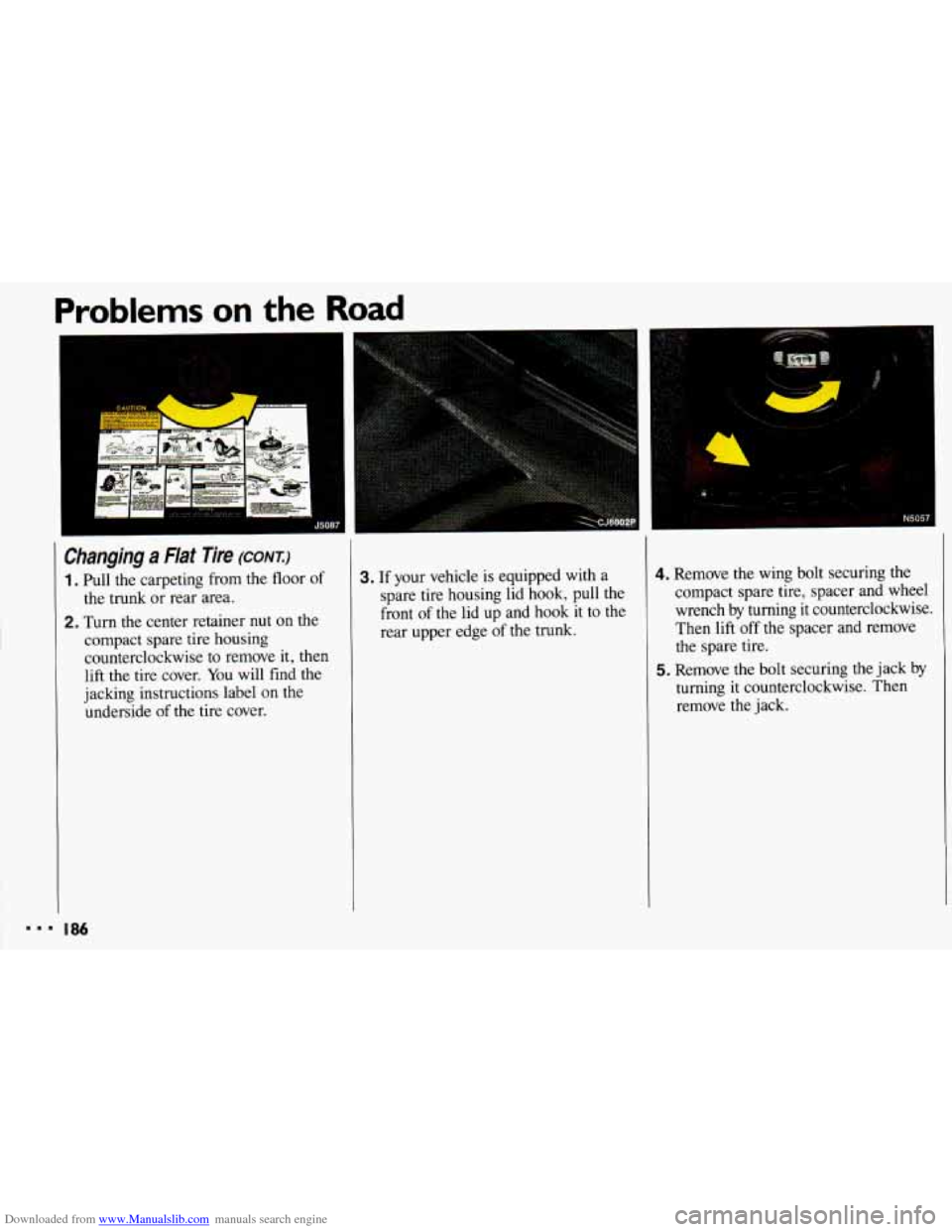
Downloaded from www.Manualslib.com manuals search engine Problems on the R
Changing a Flat Tire (CONT:)
1 . Pull the carpeting from the floor of
2. Turn the center retainer nut on the
the trunk
or rear area.
compact spare tire housing
counterclockwise to remove it, then
lift the tire cover. You will find the
jacking instructions label on the underside
of the tire cover.
3. If your vehicle is equipped with a spare tire housing lid hook, pull the
front
of the lid up and hook it to the
rear upper edge of the trunk.
4. Remove the wing bolt securing the
compact spare tire, spacer and wheel
wrench
by turning it counterclockwise.
Then lift
off the spacer and remove
the spare tire.
5. Remove the bolt securing the jack by
turning it counterclockwise. Then
remove the jack.
... I a6
Page 193 of 308
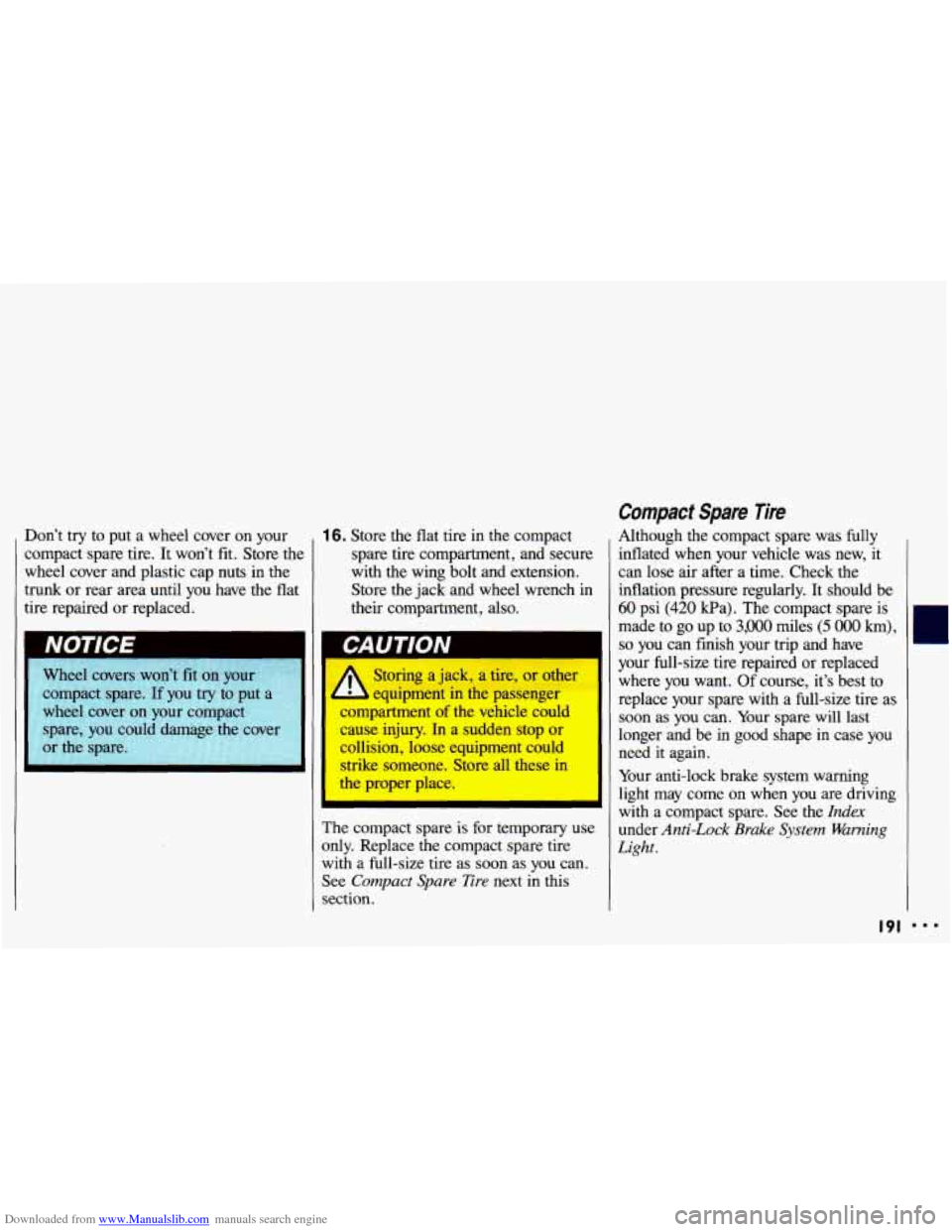
Downloaded from www.Manualslib.com manuals search engine Don’t try to put a wheel cover on your
compact spare tire.
It won’t fit. Store the
wheel cover and plastic cap nuts in the
trunk or rear area until you have the flat
tire repaired or replaced.
16. Store the flat tire in the compact
spare tire compartment, and secure
with the wing bolt and extension.
Store the jack and wheel wrench in
their compartment, also.
MU I IVN 1
Storing a jack, a tire, or other
:quipment in the passenger
compartment
of the vehicle could
cause injury. In a sudden stop
or
collision, loose equipment could
strike someone. Store all these in
the proper place.
The compact spare is for temporary use
only. Replace the compact spare tire
with a full-size tire as soon as you can.
See
Compact Spare Tire next in this
section.
Compact Spare Tire
Although the compact spare was fully
inflated when your vehicle was new, it
can lose air after a time. Check the
inflation pressure regularly.
It should be
60 psi (420 Wa). The compact spare is
made to go up to
3,000 miles (5 000 km),
so you can finish your trip and have
your full-size tire repaired or replaced
where you want.
Of course, it’s best to
replace
your spare with a full-size tire as
soon as you can. Your spare will last
longer and be in good shape in case you
need it again.
Your anti-lock brake system warning
light may come on when you are driving
with a compact spare. See the
Index
under Anti-Lock Brake System Warning
Light.
191
Page 231 of 308
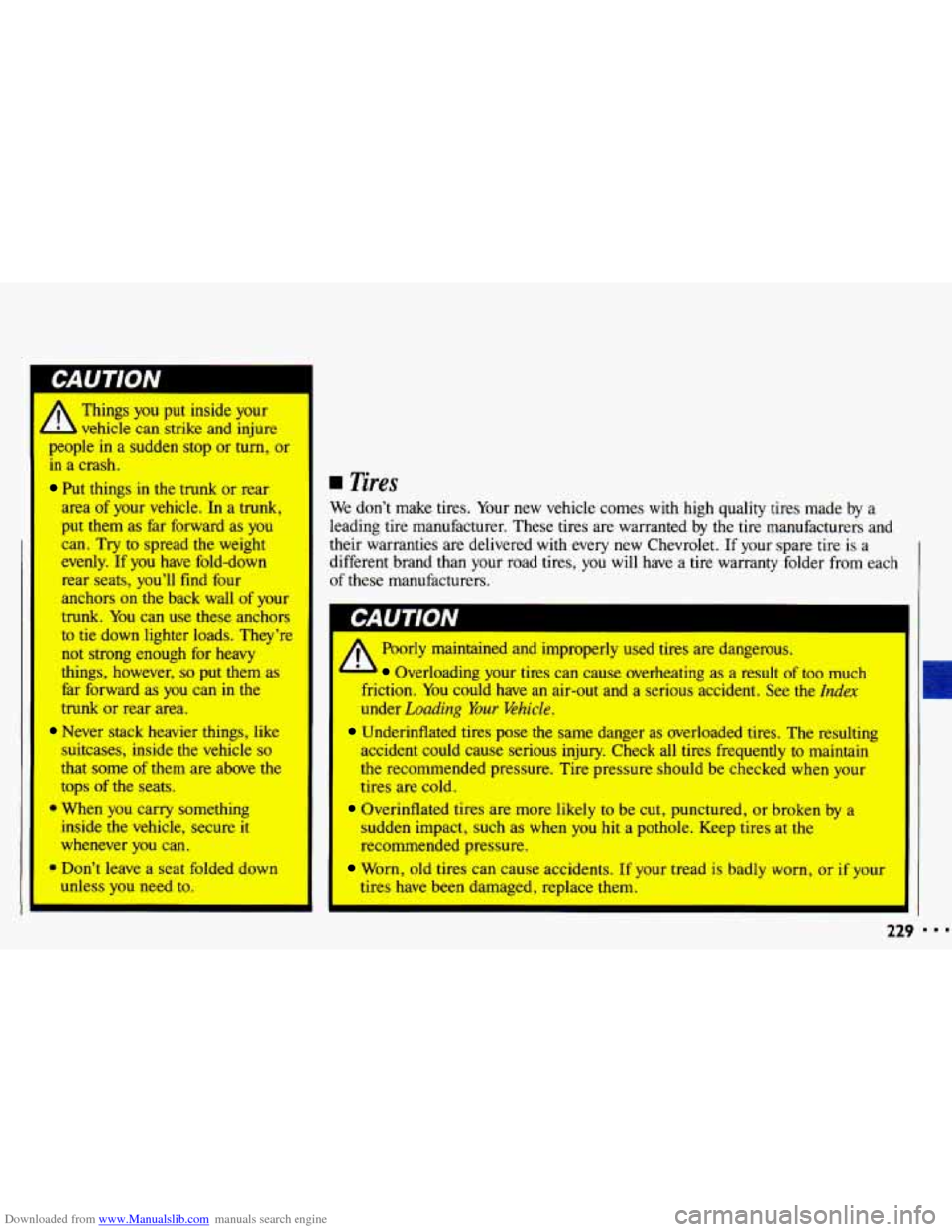
Downloaded from www.Manualslib.com manuals search engine 1--
-
Things you=
strike and injure
people in
a sudden stop or turn, or
in
a crash.
Put things in the trunk or rear
area
of your vehicle. In a trunk,
put them as hr forward as you
can.
Try to spread the weight
evenly.
If you have fold-down
rear seats, you’ll find four
anchors on the back wall
of your
trunk.
You can use these anchors
to tie down lighter loads. They’re
not strong enough for
heavy
things, however, so put them as
fbr forward
as you can in the
trunk or rear area.
Never stack heavier things, like
suitcases, inside the vehicle
so
that some of them are above the
tops
of the seats.
e When you carry something
inside the vehicle, secure it
whenever you can.
unless you need to.
0 Don’t leave a seat folded down
I
Tires
We don’t make tires. Your new vehicle comes with high quality tires made by a
leading tire manufacturer. These tires are warranted by the tire manufacturers and
their warranties are delivered with every
new Chevrolet. If your spare tire is a
different brand than your road tires,
you will have a tire warranty folder from each
of these manufacturers.
I I
CAUTION
Poorly maintained and improperly used tires are dangerous. 1
’ - Overloading your tires can cause overheating as a result of too much
friction. You could have
an air-out and a serious accident. See the Index
under hading Your Vehicle.
Underinflated tires pose the same danger as overloaded tires. The resulting
accident could cause serious injury. Check all tires frequently to maintain
the recommended pressure. Tire pressure should be checked
when your
tires
are cold.
sudden impact:
such as when you hit a pothole. Keep tires at the
recommended pressure.
I Overinflated tires are more likely to be cut, punctured, or broken by a
Worn, old tires can cause accidents. If your tread is badly worn, or if your
I tires have been damaged, replace them. I
229
I
I..
Page 301 of 308

Downloaded from www.Manualslib.com manuals search engine Identification Number.
Vehicle
................. .56. 246
Idling Your Engine
........... .68. 71
Sand. Mud. Ice or Snow
........ 192
If You're Stuck: In
Ignition
Key
......................... 48
Key Release Button ............ 55
Positions
..................... 55
Illuminated Entry System
.......... 50
Indicator Lights (see
Warning Lights)
Infant Restraint (see Child Restraints)
Inflation. Tires ................. 230
Inside Rearview Mirror
........... 85
Instrument Panel ................ 93
Instrument Panel Wming'Lights
.... 96
Intermittent Windshield Wipers
..... 83
.................... J ack. Tire 185
Jump Starting
.................. 164
Key Release Button
............. 55
Keys .......................... 48 Lane
Change Indicator
........... 73
Lap-Shoulder Safety Belt
.......... 23
Front
..................... 23. 27
Rear
........................ 28
Use by Children ........... .33. 43
Latches. Seatback
................ 14
Liftgate Ajar Light
................... 102
Lock
........................ 52
Lock Release
................. 52
Safety Warning
................ 52
Lighter
........................ 87
Dome/Map
................... 82
Headlights
................... 78
Lights
Daytime Running Lights
......... 80
Flash-to-Pass .................. 81
Instrument Panel Intensity Control
... 81
Rear Compartment
............ 82
Removing
& Replacing
Bulbs
........... .224, 225, 253
Replacement Bulbs
........... 253
Taillights
.............. .225. 253
Turn Signal
.................. 73
Warning Lights
............... 96
Loading Your Vehicle
....... .91. 227 Locks
......................... 49
Long Distance Driving
.......... 152
Low Oil Pressure Warning
........ 98
Luggage Carrier
................. 91
Low Battery
................... 164
Maintenance Record
........... 279
Maintenance Schedule
.......... 259
Malfunction Indicator Lamp
(Check Engine Light)
.......... 102
Manual Front Seat
............... 12
Manual Sunroof
................. 88
Manual Transaxle
Adding Fluid
....... .215. 250, 252
Shifting
..................... 64
Master Cylinder. Brake
.......... 221
Methanol in Gasoline
........... 198
Mileage Indicator
Mirrors Checking
Fluid
............... 213
Starting the Engine
............ 56
(see
Odometer & Speedometer)
Convex Outside ............... 85
Inside Manual Day/Night ....... 85
299 m ..
Page 304 of 308
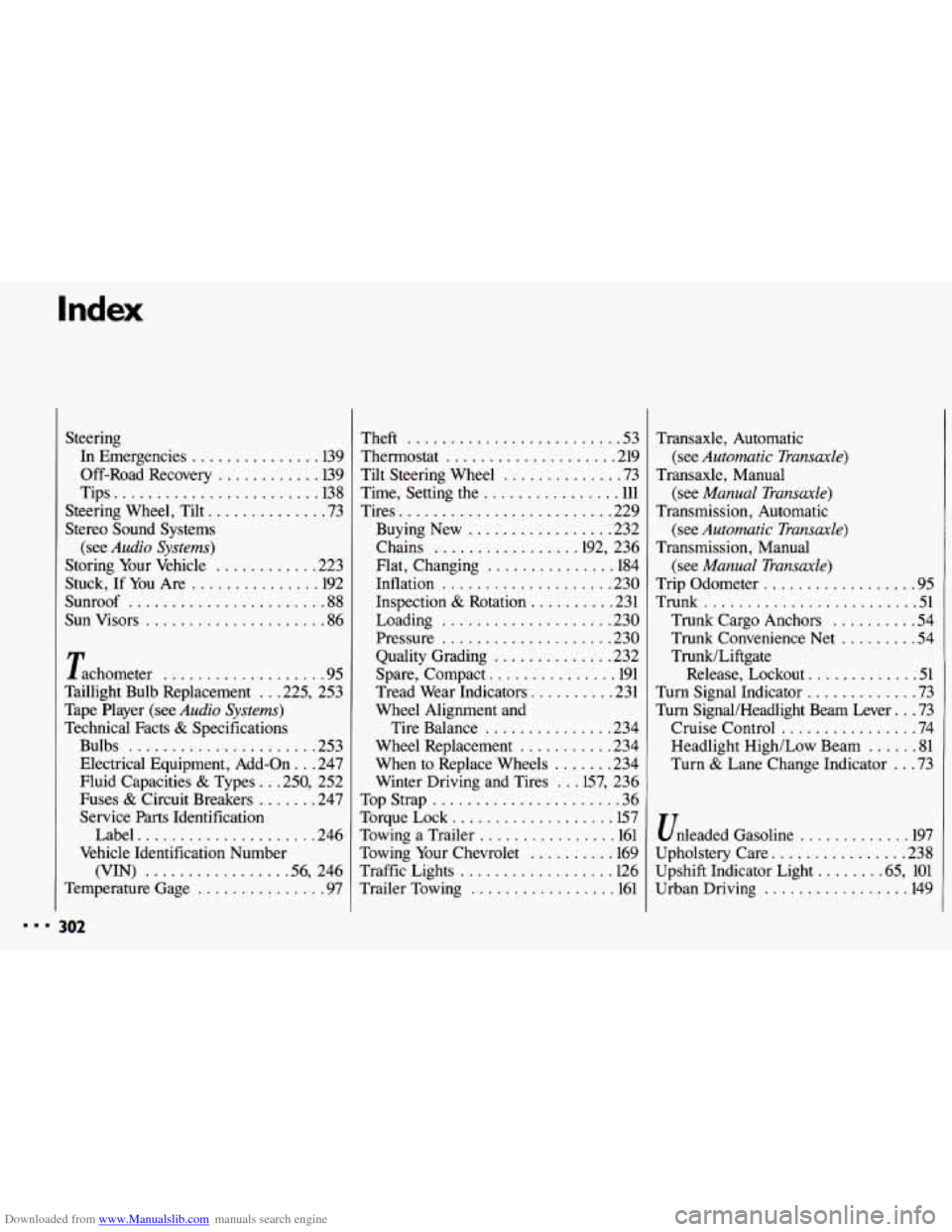
Downloaded from www.Manualslib.com manuals search engine Index
Steering In Emergencies
............... 139
Off-Road Recovery
............ 139
Tips
........................ 138
Steering Wheel. Tilt
.............. 73
Stereo Sound Systems (see
Audio Systems)
Storing Your Vehicle ............ 223
Stuck. If You Are
............... 192
Sunroof
....................... 88
Sun Visors ..................... 86
Tachometer ................... 95
Taillight Bulb Replacement.
.. .225. 253
Tape Player (see
Audio Systems)
Technical Facts & Specifications
Bulbs
...................... 253
Electrical Equipment. Add-on
... 247
Fluid Capacities
& Types .. .250, 252
Fuses
& Circuit Breakers ...... -247
Service
Parts Identification
Label
..................... 246
Vehicle Identification Number
(VIN)
................. 56. 246
Temperature Gage
............... 97
102
Theft ......................... 53
Thermostat
.................... 219
Tilt Steering Wheel .............. 73
Time. Setting the
................ 111
Tires
......................... 229
Buying New
................ -232
Chains
................ .192. 236
Flat. Changing
............... 184
Inflation
.................... 230
Inspection
& Rotation .......... 231
Loading
.................... 230
Pressure
.................... 230
Quality Grading
.............. 232
Spare. Compact
............... 191
Tread Wear Indicators
......... -231
Wheel Alignment and
Tire Balance
............... 234
Wheel Replacement
........... 234
When
to Replace Wheels ....... 234
Winter Driving and Tires
.. .157. 236
Top Strap
...................... 36
Torque Lock
................... 157
Towing a Trailer
................ 161
Towing Your Chevrolet
.......... 169
Traffic Lights
.................. 126
Trailer Towing
................. 161 Transaxle. Automatic
(see
Automatic Transaxle)
Transaxle. Manual (see
Manual Transaxle)
Transmission. Automatic
(see
Automatic Transaxle)
Transmission. Manual
(see
Manual Transaxle)
Trip Odometer .................. 95
Trunk
......................... 51
Trunk Cargo Anchors .......... 54
Trunk Convenience Net
......... 54
Trunk/Liftgate Release, Lockout
............. 51
Turn Signal Indicator
............ -73
Turn SignaYHeadlight Beam Lever
... 73
Cruise Control
................ 74
Headlight High/Low Beam
...... 81
Turn & Lane Change Indicator ... 73
Unleaded Gasoline
............. 197
Upholstery Care
................ 238
Upshift Indicator Light
....... .65. 101
Urban Driving
................. 149